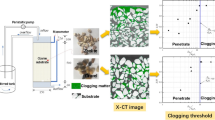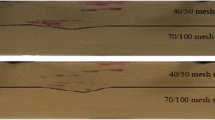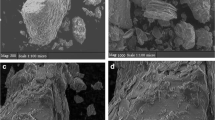Abstract
Glass-etched micromodel and visualization technology were used to research the removal mechanisms of residual light non-aqueous phase liquids (LNAPLs) droplets at pore scale. In this research, n-hexadecane was selected as the LNAPL model substance. During the injection of de-ionized water into the pore channel, residual n-hexadecane droplet was removed quickly at first, then gradually became slow and finally remained nearly invariable; the droplet size after a definite time depends on its initial value. The relationship between total volume of residual n-hexadecane and time can be described by a logarithmic equation: V = V 0 − 0.0152lnt + 0.0360 (0 < t < 9,420, R 2 = 0.9621). Based on percolation theory, the relationship between fluid percolation velocity in pores and time was determined through the analysis of residual n-hexadecane droplet size and the flowing characteristics of injected fluid. Gaussian model was used to fit the cumulated dissolved n-hexadecane, the correlation coefficient R 2 = 0.97269. The removal process of n-hexadecane in network model experiment is similar to that of the sand column flushing experiment, which indicates that the mass transfer micro-mechanism of network model experiment could be used to interpret the results of column flushing experiment.






Similar content being viewed by others
References
Boving TB, Brusseau ML (2000) Solubilization and removal of residual trichloroethene from porous media: comparison of several solubilization agents. J Contam Hydrol 42:51–67
Bradford SA, Rathfelder KM, Lang J, Abriola LM (2003) Entrapment and dissolution of DNAPLs in heterogeneous porous media. J Contam Hydrol 67:133–157
Campbell BT, On FM (1985) Flow visualization for CO2/crude-oil displacement. SPE 25:665–678
Cooper GS, Peralta RC, Kaluarachchi JJ (1998) Optimizing separate phase light hydrocarbon recovery from contaminated unconfined aquifers. Adv Water Resour 21:339–350
Corapcioglu MY, Fedirchuk P (1999) Glass bead micromodel study of solute transport. J Contam Hydrol 36:209–230
Corapcioglu MY, Chowdhury S, Roosevelt SE (1997) Micromodel visualization and quantification of solute transport in porous media. Water Resour Res 33:2547–2558
Duffield AR, Ramamurthy RS, Campanelli JR (2003) Surfactant enhanced mobilization of mineral oil within porous media. Water Air Soil Pollut 143:111–122
Egbogah EO, Dawe RA (1980) Microvisual studies of size distribution of oil droplets in porous media. B Can Petrol Geol 28:200–203
Fatt I (1956a) The network model of porous media I. Capillary characteristics. Pet. Trans. AIME 207:144–159
Fatt I (1956b) The network model of porous media II. Dynamic properties of a single size tube network. Pet Trans AIME 207:160–163
Fatt I (1956c) The network model of porous media III. Dynamic properties of networks with tube radius distribution. Pet Trans AIME 207:164–181
Jeong SW, Corapcioglu MY (2003) A micromodel analysis of factors influencing NAPL removal by surfactant foam flooding. J Contam Hydrol 60:77–96
Jeong SW, Corapcioglu MY, Roosevelt SE (2000) Micromodel study of surfactant foam remediation of residual trichloroethylene. Environ Sci Technol 34:3456–3461
Jia C, Shing K, Yortsos YC (1999) Visualization and simulation of non-aqueous phase liquids solubilization in pore networks. J Contam Hydrol 35:363–387
Lee D, Cody RD, Kim DJ, Choi S (2002) Effect of soil texture on surfactant-based remediation of hydrophobic organic-contaminated soil. Environ Int 27:681–688
Putzlocher R, Kueper BH, Reynolds DA (2006) Relative velocities of DNAPL and aqueous phase plume migration. J Contam Hydrol 88:321–336
Reddi LN, Menon S, Pant A (1998) Pore-scale investigations on vibratory mobilization of LNAPL ganglia. J Hazard Mater 62:211–230
Sahloul NA, Ioannidis MA, Chatzis I (2002) Dissolution of residual non-aqueous phase liquids in porous media: pore-scale mechanisms and mass transfer rates. Adv Water Resour 25:33–49
Sharmin R, Ioannidis MA, Legge RL (2006) Effect of nonionic surfactant partitioning on the dissolution kinetics of residual perchloroethylene in a model porous medium. J Contam Hydrol 82:145–164
Taylor TP, Rathfelder KM, Pennell KD, Abriola LM (2004) Effects of ethanol addition on micellar solubilization and plume migration during surfactant enhanced recovery of tetrachloroethene. J Contam Hydrol 69:73–99
Theodoropoulou MA, Karoutsos V, Kaspiris C, Tsakiroglou CD (2003) A new visualization technique for the study of solute dispersion in model porous media. J Contam Hydrol 274:176–197
Theodoropoulou MA, Sygouni V, Karoutsos V, Tsakiroglou CD (2005) Relative permeability and capillary pressure functions of porous media as related to the displacement growth pattern. Int J Multiphas Flow 31:1155–1180
Ting YP, Hu HL, Tan HM (1999) Bioremediation of petroleum hydrocarbons in soil microcosms. Res Environ Biotechnol 2:197–218
Vasudevan N, Rajaram P (2001) Bioremediation of oil sludge-contaminated soil. Environ Int 26:409–411
Wardlaw N (1982) The effects of geometry, wettability, viscosity and interfacial tension on trapping in single pore-throat pairs. J Can Petrol Tech 21:21–27
Wood AL, Enfield CG, Espinoza FP, Annable M, Brooks MC, Rao PSC, Sabatini D, Knox R (2005) Design of aquifer remediation systems: (2) Estimating site-specific performance and benefits of partial source removal. J Contam Hydrol 81:148–166
Acknowledgments
This study was financially supported by the National Natural Science Foundation of China (40772148).
Author information
Authors and Affiliations
Corresponding author
Rights and permissions
About this article
Cite this article
Li, H., Chen, J. & Yang, J. Pore-scale removal mechanisms of residual light non-aqueous phase liquids in porous media. Environ Earth Sci 64, 2223–2228 (2011). https://doi.org/10.1007/s12665-011-1050-8
Received:
Accepted:
Published:
Issue Date:
DOI: https://doi.org/10.1007/s12665-011-1050-8




